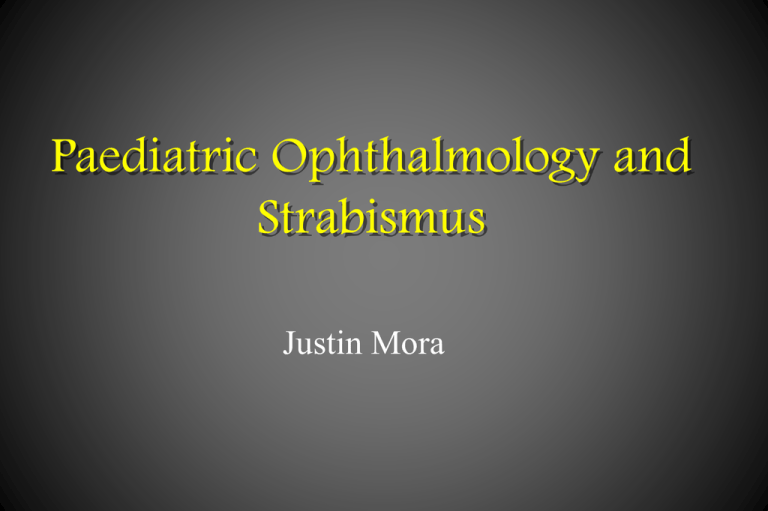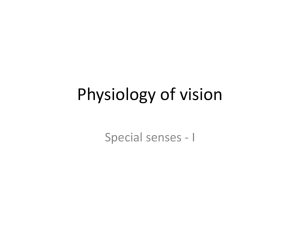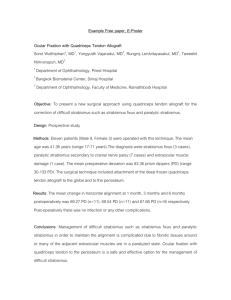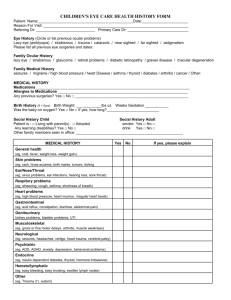Paediatric Ophthalmology and Strabismus
advertisement

Paediatric Ophthalmology and Strabismus Justin Mora Paediatric Ophthalmology • • • • • Key problems in Paediatric Ophthalmology Assessing vision in children Assessing strabismus Types of strabismus Management of strabismus Nasolacrimal Duct Obstn • • • • Common, congenital, failure to canalize Recurrent tearing and infections 95 % resolve by 12/12. If not, unlikely to Surgery to probe duct and open Leukocoria (White Pupil) • Any opacity in the visual axis • Corneal e.g.: glaucoma, metabolic, trauma • Aqueous and vitreous e.g.: uveitis • Lens e.g.: cataract • Retinal e.g.: retinoblastoma, retinopathy of prematurity, retinal inflammatory disease Retinoblastoma • Malignant . 1 in 20,000 • Mutation of tumour suppressor gene at 13q14.1 • 65 % sporadic, 25 % heritable, 10 % inherited with FHx • 1/3 bilateral • Rx gives high survival • Risk of other malignancies with heritable forms Congenital Cataract • Occurs in about 1 in 2000 • 65% sporadic 20% inherited 15% systemic or ocular problems e.g.: Down’s, Peter’s • Detected by absent red reflex Congenital Cataract • Surgery ideally performed by 4-6 wks • Vision corrected with contact lenses • Implants possible down to 6 months Congenital Glaucoma • 1 in 10,000. Congenitally abnormal drainage angle • May be associated with systemic conditions • Photophobia, tearing, hazy corneas and buphthalmos (enlargement of the eye) • The management is generally surgical Strabismus = squint = misaligned eyes • Esotropia = ET = convergent squint • Exotropia = XT = divergent squint • Hypertropia = Eye is deviated up • Hypotropia = Eye is deviated down Refraction • Hyperopia = longsighted, extra accomodation needed • Myopia = shortsighted, near images may be clear • Astigmatism = irregular eye surface, images focus in different planes • Anisometropia = the two eyes focus at different positions relative to the retinas Normal Visual Development • At birth : VA = 3/60, no fixation, variable XT • VA = 6/12 by 6-12 months • Infants usually hyperopic • Eyes should be straight by 2 months with good fixation • Any strabismus at 3 months needs assessment Measuring Visual Acuity • Infant: fix and follow, preferential looking tests, assymetrical objection to occlusion, fixation preference, optokinetic nystagmus • 2 yrs: Kay’s Pictures • 2 ½ yrs: Tumbling E’s • 3 yrs: Sheridan-Gardner • 4-5 yrs: Snellen Acuity Amblyopia (Dull Eye) • Poorer development of the visual cortex due to a blurred visual input. Brain not an eye problem • The younger the child the greater the risk but also a greater the likelihood of successful Rx • System fixed and no Rx possible by 7-8 years Causes of Amblyopia • Refractive – anisometropia > astigmatism > hyperopia > myopia • Strabismus - treating amblyopia prior to surgery improves stability of outcome • Stimulus deprivation e.g.: cataract, overpatching Amblyopia Treatment • Patching : Good eye is occluded (patched) – part-time only – 2 hours per day is good starting point – full time max 1 week per year of age – compliance is the key • Penalization : good eye is blurred with Atropine. – Beware of cycloplegic toxicity: facial flushing, rapid heart rate, confusion, irritability, seizures • PEDIG studies confirm similar effectiveness Management Issues • Young children need to be treated gently • Cycloplegic refraction is vital – allow 40 mins for cycloplegia • Strabismus is assessed with prism cover tests in 9 cardinal gaze positions depending on concerns • Motility is assessed, versions and ductions • The media and fundi are examined Assessing Strabismus • Corneal Light Reflex Test Reflexes should be symmetrical just nasal to visual axis Reflex displaced temporally = Esotropia Reflex displaced nasally = Exotropia Assessing Strabismus • Cover Test – cover straight eye – if other eye moves it was deviated – if it moves in = exotropia / divergence – if it moves out = esotropia / convergence Cover Testing Prism Cover Testing • Measures angle of deviation • Prism over deviating eye • Prism orientation: – ET = BO , XT = BI • Adjusted until no movement • Performed at near and distance and in different gaze positions • Tables and experience used to calculate amount of surgery for deviation measured Pseudoesotropia • Broad epicanthic folds • Medial sclera is buried with lateral gaze so the eyes look esotropic / convergent • Corneal light reflex and cover test confirms straight • The only “Strabismus” a child will “grow out of” Infantile Esotropia • • • • • • • Onset from birth to 2 months of age Due to poor fusion Need to treat amblyopia before surgery Surgery for fusion (stability) and 3D Ideal time to operate is 6 - 12 months Results poor if operate > 2 years 50 % require further surgery Refractive Esotropia • Onset 18 mths to 5 years • Due to hyperopia and accomodative response stimulating convergence • Many straighten with glasses alone, if given full hyperopic correction • Some with residual ET also require surgery Intermittent Exotropia • • • • Onset 2 - 5 years Usually worse at distance May close eye in bright light 60% progress to constant XT, 35% stable, 15% improve • Surgery to preserve depth perception or for cosmesis • Control & proportion of time XT important Superior Oblique Palsy • Often congenital, may break down later in life. May be acquired. e.g.: trauma • SO underaction, IO overaction, ipsilateral hypertropia worse on contralateral gaze and ipsilateral tilt • Surgery often IO weakening or SO tuck Principles of Strabismus Surgery • Muscles can be – weakened (recession, myotomy, myectomy) – strengthened (resection, tuck) – repositioned (transposition, Faden) • Surgery on paralyzed muscles is poorly effective • Amount of surgery depends on size of squint Recession / Weakening Resection / Strengthening











